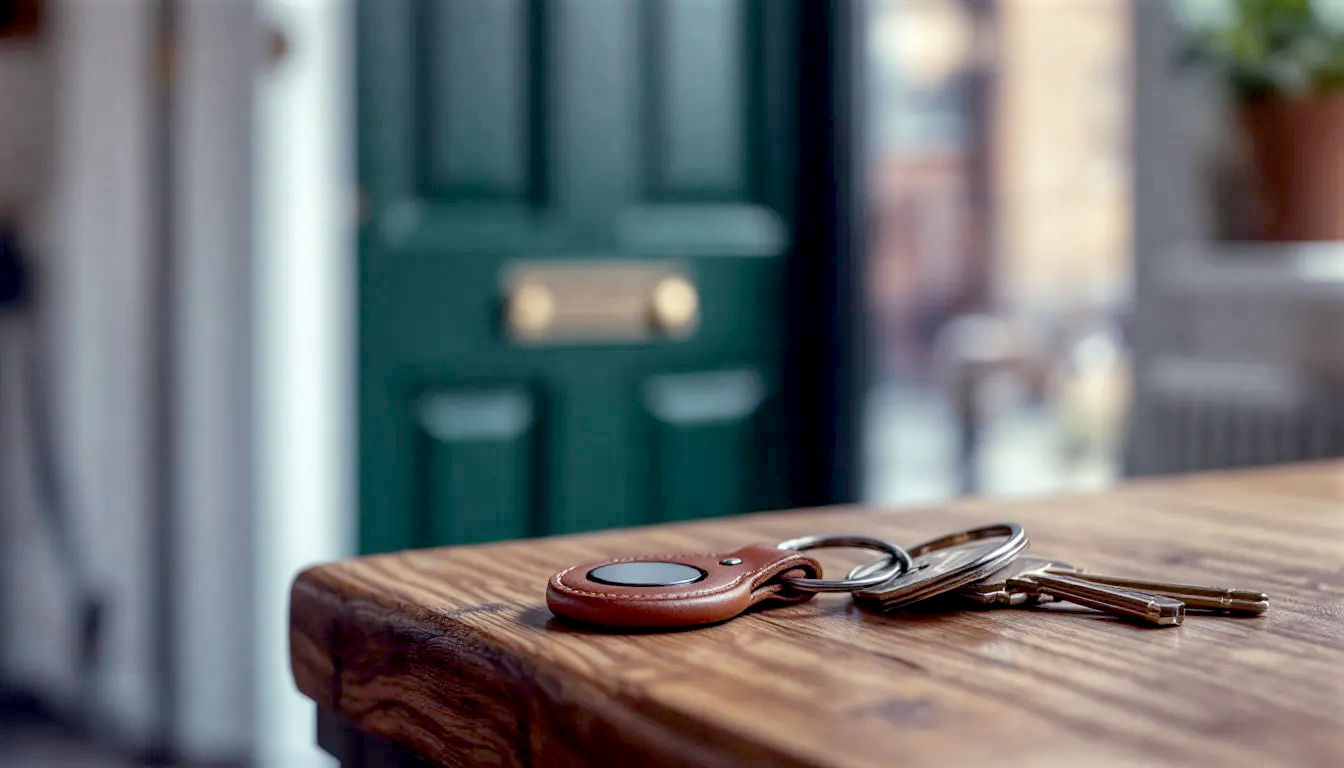The UK Guide to Apple AirTags: Never Lose Anything Again?
The guide to Apple’s item finder for a UK audience. We break down how AirTags work, their real-world uses, the privacy debate, and if they’re right for you.

This post may contain affiliate links. If you make a purchase through these links, we may earn a commission at no additional cost to you.
We’ve all been there. That sinking feeling on a drizzly Tuesday morning when you’re already late for work, but your car keys have vanished. You’ve checked the bowl by the door, patted down every coat pocket, and peered under the sofa, but they’re gone. It feels like they’ve been swallowed by a black hole, right next to all those missing socks. For decades, this was just an annoying part of life. A tiny, infuriating mystery.
Then, in 2021, Apple waltzed in with a solution that felt both incredibly clever and slightly magical: the Apple AirTag.
This small, white-and-silver disc, no bigger than a £2 coin, promised to end the frantic daily search. It’s a simple idea: attach an AirTag to your keys, slip one in your wallet, or tuck it into your luggage, and you can track it from your iPhone. But behind this simple promise is a ridiculously powerful network that turns almost every Apple device on the planet into a helper for finding your lost stuff.
-
Track Your Items in the Find My App: Keep a close eye on your keys, wallet, or backpack right alongside your Apple devices and friends within the Find My application.
-
Seamless One-Tap Setup: Getting started is effortless. A single tap is all it takes to instantly pair the tracker with your iPhone or iPad.
-
Find Nearby Items with Sound and Siri: Misplaced something close by? Simply play a sound from the built-in speaker to locate it, or ask Siri for a helping hand.
-
Pinpoint-Accurate Precision Finding: For iPhone 11 users and later, Ultra Wideband technology guides you directly to your item with on-screen directional arrows and distance feedback.
-
Leverage a Global Finding Network: If your item is further away, the Find My network—comprised of hundreds of millions of Apple devices—can securely and privately help you locate it.
-
Get Notified with Lost Mode: Activate Lost Mode, and you’ll automatically receive a notification the moment your item is detected by another device in the network.
-
Designed for Uncompromising Privacy: Your privacy is protected every step of the way. All communication on the network is anonymous and encrypted, and no location history is ever stored on the device itself.
-
Durable Design with Long Battery Life: Built to handle daily life, this tracker is IP67 water and dust resistant and features a standard user-replaceable battery that lasts for over a year.
-
Broad Apple Device Compatibility: Works seamlessly with a wide range of devices, requiring iOS 14.5, iPadOS 14.5, or later.
This isn’t just another gadget. It’s a peek into a future where losing things could become a thing of the past. But is it really the perfect solution? Does it work as well in the quiet hills of the Peak District as it does on a crowded London street? And what about the darker side—the privacy worries that came along with a pocket-sized tracker?
This is the ultimate guide to the Apple AirTag for anyone in the UK. We’ll break down exactly how it works (without the confusing tech jargon), explore the clever ways people are using them, and tackle the serious questions about safety and privacy. By the end, you’ll know everything you need to decide if this little disc is the answer to your lost-and-found prayers.
What Exactly Is an Apple AirTag?
Before we dive into the clever tech, let’s get the basics right. An Apple AirTag is a small, coin-shaped item finder. It’s not a GPS tracker like the ones you might see in spy films. It doesn’t have a satellite connection or a monthly subscription fee.
Instead, it’s a beautifully simple piece of kit designed to do one job: help you find your personal belongings.
Think of it as a tiny digital beacon that constantly whispers, “I’m here!” It does this using Bluetooth, a short-range radio signal. The AirTag itself is a passive little thing; the real magic happens when you pair it with an Apple device, like an iPhone or an iPad.
Here’s what you get in the box:
- The AirTag: A sleek, shiny disc made of plastic and stainless steel. The steel side can be engraved for free by Apple with your initials or an emoji, which is a nice touch.
- A Replaceable Battery: It’s powered by a standard CR2032 coin battery—the same kind you’d find in a watch or kitchen scales. Apple says it should last for about a year, and you can easily buy replacements from places like Boots or Amazon.
- Minimalist Design: The AirTag itself has no holes or loops. It’s a smooth pebble. This is classic Apple design, but it does mean you’ll almost certainly need to buy a separate accessory, like a keyring or holder, to attach it to anything.
Once you’ve unboxed it, the setup is famously easy. You just pull a plastic tab to activate the battery and hold it near your iPhone. A pop-up appears on your screen, you give your AirTag a name (like “Car Keys” or “Backpack”), and that’s it. It’s now linked to your Apple ID and visible in the Find My app, the same app you might use to find a lost iPhone or see where your friends are.
Crucially, AirTags only work with Apple devices. You can’t use them with an Android phone. This isn’t just a marketing choice; it’s because the entire system relies on Apple’s huge network of products, which we’ll explore next.
How the Magic Works: A Deep Dive into the Technology
So, how does this little disc find your keys when they’re lost somewhere in the supermarket car park? It’s a brilliant combination of three different technologies, working together seamlessly.
Level 1: Bluetooth for Close-Range Finding
Let’s say you’ve lost your keys somewhere in the house. They’re within about 10-20 metres, which is the rough range of a Bluetooth signal.
In this case, it’s simple. You open the Find My app on your iPhone, select your keys, and tap “Play Sound.” The AirTag has a tiny built-in speaker that will start beeping—a series of chirps that are surprisingly loud for something so small. You can then follow the sound until you find your keys wedged between the sofa cushions. It’s like a high-tech game of hide-and-seek.
This is the most basic function, and it’s perfect for those everyday “where on earth did I put it?” moments.
Level 2: The Find My Network for Long-Range Finding
This is the secret sauce. This is what makes AirTags so much more powerful than older Bluetooth trackers. What happens if you left your bag on a train to Brighton or dropped your wallet in Hyde Park? It’s far outside your iPhone’s Bluetooth range.
This is where the Find My network kicks in.
Apple has quietly built one of the world’s largest crowdsourced location networks. There are over a billion active Apple devices—iPhones, iPads, and Macs—all over the globe. The Find My network turns every single one of these devices into an anonymous search party for your lost AirTag.
Here’s how it works, step-by-step:
- Your AirTag sends out a secure, anonymous Bluetooth signal. This signal is like a digital flare, constantly saying, “I’m here, and my ID is XYZ.”
- Any nearby Apple device detects this signal. If someone with an iPhone walks past your lost bag, their phone will “hear” the AirTag’s signal in the background. This happens automatically and privately. The person whose phone detected it won’t get a notification and will have no idea it even happened.
- The nearby device sends the location to Apple. The helper’s iPhone will take the location where it detected the AirTag and securely upload it to Apple’s servers. This is all done with heavy encryption, so not even Apple knows which device spotted your tag or where it is.
- You see the location in your Find My app. You can then open your app and see a pin on a map, showing you the last known location of your AirTag.
Think of it like a city-wide neighbourhood watch for your lost stuff. It’s incredibly effective in populated areas like British towns and cities because there are almost always iPhones nearby. A lost item in central Manchester or on the London Underground will likely get its location updated within minutes. However, if you lose something on a remote hiking trail in the Scottish Highlands, you’ll have to wait until another rambler with an iPhone passes by.
Level 3: Precision Finding for the Final Few Feet
Okay, so the Find My network has guided you to the right street, and the map says your keys are somewhere nearby. But where, exactly? Are they in the gutter, under a car, or in a hedge?
This is where Precision Finding comes in. If you have an iPhone 11 or newer, your phone is equipped with an Apple U1 chip, which uses Ultra Wideband (UWB) technology. This is like a super-accurate, indoor GPS.
When you get close to your AirTag, you can tap the “Find” button in the app. Your iPhone screen will transform into a directional guide. It will show you an arrow pointing directly towards your AirTag and tell you the exact distance, right down to the inch. As you walk, the phone gives you haptic feedback—little vibrations that get stronger as you get closer.
It’s like playing a game of “you’re getting warmer.” The screen might say “5 feet away… to your left,” then “2 feet away… right in front of you,” until it finally declares “Here.” It’s an incredibly satisfying feature that removes the final bit of guesswork.
Lost Mode: When a Stranger Finds Your Item
What if someone who doesn’t have an iPhone finds your lost keys? Apple thought of that, too. You can put your AirTag into Lost Mode using the Find My app.
When you do this, you can write a custom message and include your phone number. If someone finds the item, they can tap the AirTag with any smartphone that has NFC (Near Field Communication)—which includes most modern Android phones. Tapping it will open a web page showing your message and phone number, so they can contact you.
It’s a clever, simple way to turn a lost item into a found one, even if the finder is outside the Apple ecosystem.
Real-World Uses: More Than Just Keys and Wallets
The most obvious use for an AirTag is on a set of keys or in a wallet, but people across Britain have found some genuinely brilliant ways to use them.
Luggage Tracking: The Heathrow Saviour
This has become the killer app for AirTags. We’ve all felt that pang of anxiety at the baggage carousel, watching identical black suitcases circle endlessly. Is yours even on the flight?
By slipping an AirTag into your checked luggage, you can get rid of that worry. You can open the Find My app while you’re still on the plane and see if your bag made it to the same airport as you. Users have shared stories of finding “lost” luggage that airlines insisted was still in another country, simply by showing staff the bag’s live location on their phone. It gives you peace of mind and, in some cases, helps you get your stuff back much faster.
Securing Your Bike
Bike theft is a massive problem in UK cities. While an AirTag won’t stop a thief with a pair of bolt cutters, it can dramatically increase your chances of getting your bike back.
People are hiding AirTags in discreet places on their bikes—under the seat, inside the frame, or within a special holder disguised as a bottle cage. If the bike gets stolen, you can pass its live location data to the police. There are countless success stories online of people recovering their stolen bikes thanks to a hidden AirTag.
Finding Your Car
Ever forgotten where you parked your car in a massive multi-storey car park like the one at the Trafford Centre or Bluewater? Dropping an AirTag in your glove box means you can use Precision Finding to guide you right back to your vehicle. It’s also an extra layer of security against theft.
Keeping Tabs on a Wandering Pet
This one comes with a big caveat. Apple is very clear that AirTags are designed to track items, not people or pets. An AirTag is not a substitute for a proper GPS pet tracker, which provides a true real-time location and often has features like “safe zone” alerts.
However, many British pet owners have found them useful as a backup. If a dog bolts out of the front door in a suburban area, the Find My network can give you a very good idea of which street it’s on. A cat that likes to wander through neighbours’ gardens might get its location pinged several times a day, giving you peace of mind. Just remember its limitations: in a rural area with few people around, it won’t be much help.
The TV Remote and Other Household Items
It’s a classic family argument: who lost the remote? Taping an AirTag to the back of the TV remote, or even to a glasses case, can put an end to those domestic squabbles once and for all.
The Dark Side: Stalking and Unwanted Tracking
We can’t have an honest discussion about AirTags without addressing the serious concerns around privacy and safety. The very technology that makes the AirTag so good at finding lost items also makes it a potential tool for stalking and abuse.
When AirTags were first released, horror stories quickly emerged. People were finding AirTags slipped into their bags or attached to their cars, allowing them to be tracked without their consent. It was a huge and legitimate worry.
To its credit, Apple responded to these concerns and has since rolled out a series of important safety features. If you are an iPhone user, these are now built directly into the system.
How Apple Protects You from Unwanted Tracking
- “AirTag Found Moving With You” Alert: If you have an iPhone, and an AirTag that isn’t registered to you is detected travelling with you over time, your phone will send you an alert. This is the most important protection. The alert will show you a map of where the AirTag has been seen with you.
- Playing a Sound: From that alert, you can make the unknown AirTag play a sound, helping you find it on your person, in your bag, or on your car.
- Finding and Disabling the AirTag: Once you find it, you can tap it with your phone to see its serial number. You can then easily disable it by twisting the back and removing the battery. Apple works with law enforcement and can, with a court order, trace the serial number back to the owner’s Apple ID.
- Automatic Beeping: An AirTag that has been separated from its owner for a period of time (between 8 and 24 hours) will automatically start playing a sound when it’s moved. This is designed to alert anyone nearby, including Android users who wouldn’t get the on-screen notification.
What About Android Users?
The initial system was criticised for not protecting Android users enough. Apple has since addressed this by releasing an app for Android called Tracker Detect. Android users can download this app and use it to manually scan their surroundings for any unknown AirTags.
While these measures have made it much harder to use an AirTag for malicious tracking, no system is perfect. It’s important to be aware of the potential risks and to know what the safety alerts on your phone look like. The message is clear: AirTags are for tracking your things, not people.
Living with an AirTag: The Day-to-Day Experience
So, what’s it actually like to use an AirTag? Here are the practical things you need to know.
Battery Life and Replacement
Apple claims the CR2032 battery will last “over a year.” In reality, this depends on how often you use features like “Play Sound” or Precision Finding. Most users report getting somewhere between 10 and 14 months of life out of one.
When the battery gets low, you’ll get a notification on your iPhone, giving you plenty of warning. Replacing it is simple: you just press and twist the stainless steel back, and it pops right off. A new battery costs about £1-£2.
The Hidden Cost of Accessories
The AirTag’s biggest design flaw is also a business opportunity for Apple and third-party manufacturers. Because it has no hole, you can’t attach it to anything out of the box. You will need to buy a holder.
- Apple’s Official Holders: These are beautifully made from leather or silicone but are famously expensive, sometimes costing more than the AirTag itself.
- Third-Party Options: Thankfully, companies like Belkin, Spigen, and countless sellers on Amazon offer a huge range of affordable keyrings, luggage tags, and stick-on mounts. You can get a perfectly good silicone loop for just a few quid.
When you’re budgeting for AirTags, remember to factor in the cost of a holder for each one.
Durability and Water Resistance
An AirTag is rated IP67, which is a standard rating for water and dust resistance. In plain English, this means it can survive being submerged in up to 1 metre of water for 30 minutes.
So, you don’t need to worry about it getting wet in the British rain. Dropping your keys in a puddle is fine. Some people have even reported their AirTagged wallet surviving a full cycle in the washing machine. It’s a tough little device built for the bumps and scrapes of everyday life.
AirTags vs. The Competition: A Quick Look
Apple wasn’t the first company to make a Bluetooth tracker. The most well-known competitor is Tile, which has been around since 2012. Samsung also has its own SmartTag for Galaxy phone users.
So how does the AirTag stack up?
- Tile: Tile trackers come in various shapes and sizes—some are flat like a credit card, others are stickers. They work with both iPhones and Androids. Their biggest weakness, however, is the size of their network. To find a lost item, it needs to be detected by another phone running the Tile app. While their network is large, it’s nowhere near the size of Apple’s Find My network, which includes almost every modern Apple device by default.
- Samsung SmartTag: This is Samsung’s answer to the AirTag and works in a very similar way, using other Galaxy devices to create a network. It’s a great choice if you’re a Samsung user, but it doesn’t work with iPhones or other Android brands.
The AirTag’s overwhelming advantage is the sheer size of the Find My network. In the UK, you are simply far more likely to get a quick and accurate location for a lost item with an AirTag than with any other tracker, purely because of the number of iPhones out there.
The Verdict: Is an Apple AirTag Worth It for You?
After diving into the technology, the practical uses, and the privacy concerns, we come to the big question: should you buy one?
An Apple AirTag is a brilliant piece of technology that solves a common, frustrating problem in an elegant and powerful way. For the price—around £29 for one or £99 for a pack of four—it offers incredible value and peace of mind.
You should definitely consider buying an AirTag if:
- You are already in the Apple ecosystem. You need an iPhone or iPad to use it.
- You frequently misplace everyday items like keys, a wallet, or a bag.
- You travel often and want to keep track of your luggage.
- You want an extra layer of security for valuable items like a bike or a car.
You might want to think twice if:
- You are an Android user. It simply won’t work for you.
- You want to track a pet in real-time. A dedicated GPS tracker with a subscription is a much safer and more reliable option.
- You are primarily concerned about losing things in very remote, rural areas. Its effectiveness depends on other people being nearby.
For most iPhone users in the UK, the Apple AirTag is a game-changer. It’s a small, affordable gadget that leverages one of the most powerful networks on the planet to bring you one simple, wonderful feeling: the relief of finding what you thought was lost forever. It may not be perfect, and the need for accessories is annoying, but for finding your stuff, it’s currently unbeatable.
Further Reading
For those who wish to delve deeper into the world of Apple AirTags and digital privacy, these resources provide authoritative information and respected perspectives.
- Apple AirTag – Official UK Product Page: The official source for product specifications, features, and purchasing options directly from Apple UK.
- What to do if you get an alert that an AirTag is with you – Official Apple Support: Apple’s essential guide on how to handle unwanted tracking alerts, explaining the safety features built into the Find My network.
- Which? – Apple AirTag Review: An independent review from the UK’s leading consumer champion, offering trustworthy analysis and lab-tested insights.
- TechRadar – Best AirTag accessories in 2025: A practical guide to the essential third-party keyrings, mounts, and holders you’ll need to make the most of your AirTag.
- The Guardian: Technology – AirTags Topic Page: For ongoing news, analysis, and discussion on the societal and privacy implications of item trackers from a respected British news outlet.







